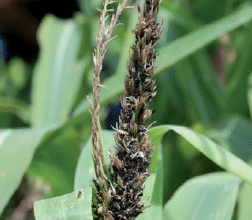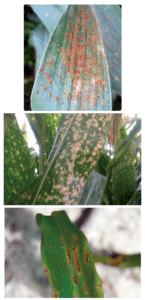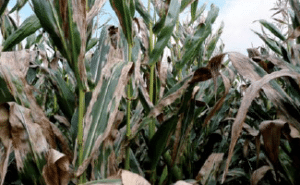
Crop Protection – Diseases
Maize is generally little affected by cryptogamic diseases. This “ecological advantage” is due to the plant’s origins and the fact that maize was historically bred without resort to phytosanitary protection.
Controlling Maize Diseases: Strategies Based on Risk Level
Disease risks are therefore to be limited through various preventive measures:
- regular monitoring of plots, to spot the hybrids or areas at risk,
- crop residue management – to diminish any potential infestation/burrowing by disease vectors such as insects and borer-type vermin –, along with harvesting early enough, carrying out risk-based tillage operations (ploughing), etc,
- choosing the right hybrids depending on the regions, when planting: using hybrids that are tolerant to helminthosporiosis or Fusarium.
In dry, continental summers and with rotated maize, the risk of certain diseases is lower. However, depending on the year and region, maize may be exposed to local damage. Good hybrid selection and an efficient integrated management help control helminthosporiosis and Fusarium, which present the highest risks. Foliar diseases may trigger significant yield losses when they are highly necrotic, when they settle in early, and when crops are harvested late.
Quick Overview of Common Maize Diseases
Root necroses
Triggered by the development of several types of fungi (Pythium spp., Fusarium spp., Rhizoctonia spp. – often occurring simultaneously), root necroses result in significant plant lodging in specific locations, which become visible at harvest time. To limit any further development after having spotted the areas or the hybrids at risk, one should apply proper agronomic management practices: preparing the soil and ploughing in good conditions – including a second pass on sufficiently dried-out soil.
In addition, a good precaution – especially with Rhizoctonia – consists of localised, seed-row treatments with products such as azoxystrobin, of the chemical family of strobilurins.
Helminthosporiosis
Several variants of helminthosporiosis exist, with variable damage potential. Usually occurring after flowering, the attacks can be violent and can cause the photosynthetic capacity of maize to collapse. In the most challenging situations, with crops that develop early and fast, grain yield losses may reach 20 to 50 percent.
The producer must be aware of the hazardous situations in order to be able to take the necessary prevention measures.
Plot-related risks are higher in the following situations:
- areas displaying an endemic development of helminthosporiosis – or strong attack thereof observed in the previous year,
- repeated use of sensitive hybrids – especially under monoculture conditions,
- shallow tillage (drilling); not chopping crop residues,
- proximity of cribs or driers.
To control helminthosporiosis, one must take a few simple precautions, such as:
- crop scouting,
- fine chopping and burying of maize crop residues,
- choosing less sensitive hybrids.
Common smut and head smut

Common smut is the most frequent corn disease. The Ustilago maydis spores are naturally present in the crop’s environment and are highly volatile. Contamination often takes place through “natural” entryways (the silks) or otherwise tissue injuries caused by parasites (Oscinia spp) or by herbicide phytotoxicity, as well as kernel or ear abortion, or water deficit. The fungus grows on young or developing plant organs (apex, axillary buds, inflorescences, etc). The disease rarely causes damages. There are no treatments for it. Controlling the risk factors mentioned above remains the most efficient method – however, with no guarantees. A certain amount of sensitivity to it exists in specific hybrids, whether directly or indirectly (to insect pests and parasites, accidents etc).
Heat smut is a disease that occurs less frequently, but can cause significant yield losses. Typical head smut symptoms – due to Sphacelotheca reiliana – only become visible after flowering and are found on the plant’s reproductive organs, tassels, and ears. The soil is the main source of inoculum. The same factors that weaken and slow down the growth of young plants – such as early drought and soil compaction – also favour the development of the disease inside the plant. This is one of the reasons why symptoms are often noticeable along field edges. Certain hybrids are more susceptible to head smut than others.
Other foliar diseases: rust, eyespot (Kabatiella zeae), and anthracnose

These diseases rarely cause serious damage and their economic impact is limited. Crop residue burial, tillage, and crop rotation limit the infection potential. Monoculture and direct drilling increase risks. Rust and eyespot occur mostly in regions with a cool oceanic climate and after flowering.
Anthracnose occurs earlier (before flowering) and in hot, stormy climates characterised by frequent rainfalls. Symptoms differ from one hybrid to another, but the low incidence of the disease and the moderate damage it causes to hybrids have not justified any specific breeding work so far.
Preventive measures
The complex interaction among climate, technical itinerary and hybrid sensitivity calls for several ways of action, in order to prevent potential cumulative effects:
- Crop residue management and soil tillage right after harvesting the previous crop. Soil surface residues represent potential sources of infection to the following maize crop, both in terms of Fusarium and corn borers. Chopping stalks right after harvest and tilling them under as mulch into the topsoil promote decomposition of the organic matter – the “supporting structure” of pathogens. Chopping and rooting out are also highly effective, as they reduce hibernation possibilities of Ostrinia and Sesamia spp. However, these measures depend on the actual harvest, and weather, conditions and they are easier to implement if harvesting does not take place too late;
- Early planting dates and proper hybrid earliness allow the crops to mature early and help to avoid the risk of Fusarium ear rot development, which is favoured by warm and humid autumns. Early planting speeds up the production cycle and allows the kernel to reach lower water contents when autumn hygrometry rebecomes favourable to fungal development;
- Hybrid choice: choosing an early-maturity hybrid that is best adapted to the region and is suitable for early harvesting remains the best precaution. In case of no-till planting or without any accompanying soil work that would enable good residue degradation, one should avoid using the most sensitive hybrids. The hybrid producer’s specifications or otherwise field scouting during the month before the harvest should assist the grower in removing the more sensitive material;
- Protecting plots against Ostrinia and Sesamia spp. (entryways to fungi) becomes a must when infestation risks justify it. The strategy consists in limiting their populations – especially those of second-generation caterpillars;
- Setting harvest dates based on kernel health condition. When disease symptoms are already present, the harvest should not be delayed beyond crop maturity, in order to prevent progress of Fusarium diseases and toxin buildup. One should start by carrying out a risk assessment a few weeks before the estimated harvest date, looking at risks associated with agronomic practices, the weather pattern during that year, any diagnoses of Fusarium damage, and lastly, the weather forecast for the following weeks.
Fusarium ear rot and sanitary quality of kernels
Commission Regulation (EC) N° 1887/2006 regarding cereals and the risk of mycotoxins calls for increased vigilance regarding the causes that trigger the latter. It is crucial for both grain and livestock growers to detect and limit kernel molds, in order to secure a crop that meets sanitary standards.
Toxins require pathogenic fungi that can produce them. This is necessary, but not sufficient. The presence of Fusarium rots on maize ears does not necessarily trigger toxin production. Extensive surveys have been conducted in the EU in order to classify and rank risk causes. It has quickly become evident that climate plays a major role in the infection with, and development of, Fusarium ear rot, as well as in the related toxin production (rainy weather at the time of silking and during the following days; post-flowering hygrometry and temperature – particularly in early autumn). Water deficit, heat stress, and borers increase vulnerability to pathogens.
As to DON and zearalenone – secreted by Fusarium graminearum –, risk factors include above all harvest date, crop maturity, hybrid sensitivity, and crop residue management.
Fumonisines are secreted by Fusarium spp. (mostly F. verticillioides and F. proliferatum), which tend to be saprophytic fungi. Fumonisines are favoured by injuries made by ear and stalk borers (Ostrinia, Sesamia, Heliothis) or kernel cracks caused by water deficit stress, or yet again by over-contamination on pathogens already present on ears (of which F. graminearum). Just as for F. graminearum, specific hybrids present certain sensitivities to these fungi.
The risk of aflatoxins B1 or B2 (which feed processors fear) is caused by certain fungi (such as Aspergillus flavus), which thrive especially on kernels stored in a hot and humid environment. The risk is lower in temperate latitudes and higher with maizes grown in the south and east of Europe.
